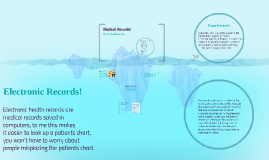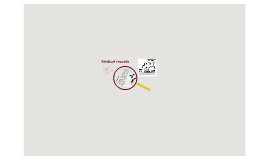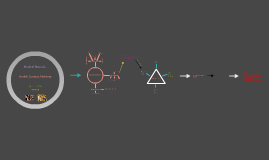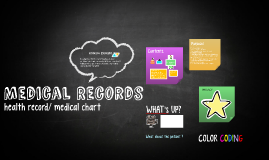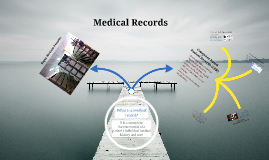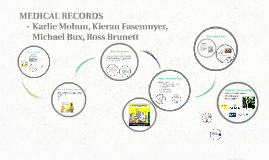MEDICAL RECORDS
Transcript: Filing In the United States, the most basic rules governing access to a medical record dictate that only the patient and the health-care providers directly involved in delivering care have the right to view the record. The patient may grant consent for any person or entity to evaluate the record. The full rules regarding access and security for medical records are set forth under the guidelines of the Health Insurance Portability and Accountability Act (HIPAA). Who has access? Different Types: Institution-standardized forms Journal style narratives SOAP notes Insurance forms Carbonless forms Why is it Important? Pros http://www.ptos.com/docsoftware.aspx https://www.webpt.com/features http://www.athletictrainersystem.com/pdf_Files/ats_pricing.pdf http://www.nata.org/pdf_Files/documentation.pdf Plenty of viable options ATS, Clinicient, PTOS, WEBPT What is a Medical Record? Seven areas with regard to HIPAA Rules: Obtain consent for treatment Obtain authorization to release health information Release only the minimum necessary information Safeguard patient information Observe state laws Do not combine authorizations Business associates must safeguard patient information HIPPA cont. ATS Medical information (personal medical history, family medical history, orthopedic history, physical examination [finding]) Evaluation of injuries Treatments Referrals Special tests and result Rx etc. Health Insurance Portability and Accountability Act of 1996: Enacted to help employee transfer their health insurance when they switched employers, to ensure that their heath information would remain private and to give people more access to their own health care information. Partially due to how much info is now electronic ATC’s are subject to HIPPA rules when each of the following three conditions apply: Furnishes, bills, or receives payment for health care The person, business, or agency conducts covered transactions. Covered transactions are transmitted in electronic form. Family Education Rights and Privacy Act of 1974: Requires educational institutions to receive formal written consent from students before they can disclose educational records to a third party. Make available to students all records relating to their enrollment Exceptions to the rule: May disclose info without consent to safeguard their health in an emergency. Write legibly in ink Identify date and time Describe provided care and patient response Chronological order Specific and soon as possible Use patient quotes Don't erase errors, draw a line through them Keep a master outline of file system Keep confidential files in their own locked cabinet Use different colors and shapes of labels Organize chronologically or alphabetically Go through all files yearly Sources Cons Variety of settings Variety of users Ease of use Vast concussion features What is in a Medical Record Cost WebPT: $50 per month ($600/year) plus $750 setup cost 98 per month per 2 therapists ATS: Single user total startup cost ~$1,000 plus ~$300 dollars in annual fees $157 per month just for EMR Communication tool Legal Responsibility/Protection: FERPA (1974) HIPPA (1996) ROI Reimbursement Research ATS Alternatives Athletic Training System (ATS) Other Important Reasons Image by Tom Mooring State statutes, the Board of Certification Standards of Professional Practice, the NATA Code of Ethics and the Athletic Training Educational Competencies insist on proper record-keeping as a key tenant of professional practice. FERPA (1974) WebPT Reliable, accurate and defensible documentation More than just injury tracking Web PT Paper Documenting Guidelines Other Clinical Settings CSMi Injury tracking software and...... MEDICAL RECORDS Karlie Mohun, Kieran Fasenmyer, Michael Bux, Ross Brunett HIPPA cont. Time consuming Double charting Decreases patient clinician interaction The terms medical record, health record, and medical/treatment chart are used somewhat interchangeably to describe the systematic documentation of a single patient's medical history and care across time within one particular health care provider's jurisdiction HIPPA (1996) Pros and Cons Cons Paperless Documenting Clinician MD interaction Accessibility and organization Clinician to clinician information sharing






